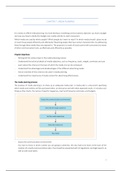CHAPTER 7 : MEDIA PLANNING
It is mainly on offline media planning. You have develop a marketing communications objective, you have a budget
and now you have to divide this budget over media vehicles to reach consumers.
Which media are used by which people? Which people do I want to reach? In which media should I place my ad
to reach these people efficiently and effectively? Reaching people that have certain characteristics, by addressing
them through these media they are exposed to. The purpose is to reach all touch points with consumers by means
of other communication tools, as effectively and efficiently as possible.
Chapter objectives
- Distinguish the various steps in the media planning process
- Understand the technical details of media objectives, such as frequency, reach, weight, continuity and cost
- Learn about the criteria on the basis of which the media mix can be composed
- Understand the advantages and disadvantages of the different advertising media
- Get an overview of the criteria to be used in media planning
- Understand the importance of media context for advertising effectiveness
The media planning process
The purpose of media planning is to draw up an adequate media plan. A media plan is a document specifying
which media and vehicles will be purchased when, at what price and with what expected results. It includes such
things as flow charts, the names of specific magazines, reach and frequency estimates, and budgets.
- Assess the communications environment
You have to know in which context you are going to advertise, this also had to be done at the start of the
creation of a media communications plan. One should be acquainted with all regulations and legal aspects, as
well as with local habits.
1
, In this the communication efforts of the competition should be judged, based on the following elements :
- Category spending: advertising spend in industry
What is the average advertising spend in the industry? 5% of turnover? What is the advertising pressure
in the industry? And how did it evolve over the last five years?
- Share of voice: your company’s share in advertising spend of the industry.
SOV is calculated by dividing a particular brand’s advertising spending by the total category spending.
One should also investigate the share of market (SOM) and how SOV relates to this SOM.
- Media mix of companies in the industry
What are your competitors doing?
- Media behaviour of target groups.
You define your target groups in an advertising groups, you try to know whom is using which media and
then you define your budget which you use to try to reach your target groups.
Media planning is about maximizing the exposure of your target group to your ad. It is planning media that
your target groups use, it is not predictive of how many people will see your ad. You select media that can
reach your target group effectively and efficiently. If they see it after this is not part of media planning.
- Describe the target audience
This is very important for media planning, since the target audiences determines your choice of which media
channels you are going to use. Media planning is about reaching the right eyeballs.
- Set the media objectives
This is the core of the chapter
- Select the media mix
- Buy media
Media objectives
2
, FREQUENCY (people should be exposed to your ad enough) x REACH (as many people as possible) = WEIGHT (I
have reached 100.000 people 3 times each, the weight of my campaign is 300.000 contacts, 300.000 pairs of
eyeballs)
CONTINUITY : how will we spread our budget across the campaign period. In one week all, of spread over three
months...?
COST : you have to pay the medium to place the ads. In order to do it cost efficiently (maximum campaign weight
at a certain budget) you have to do it in the right way.
FREQUENCY
- How many times a consumer of the target group is expected to be exposed to the advertiser’s message within
a specified time period. It is estimated on the basis of the number of times one could be exposed to the media
vehicle, and not to the message itself.
- In media planning: Exposure to the media vehicle, not to the message.
A medium vehicle = a website, a magazine, a television programme... Hopefully everyone who looked at the
medium vehicle saw also your message, but you are never sure about this last part.
Research shows that advertising repetition initially increases learning, but may lead to boredom and irritation
later. -> Ad frequency and ad effectiveness Berlyne’s two-factor theory
The theory tries to explain the relationship between frequency of repetition and ad effectiveness (brand
awareness, recall, attitude towards the brand...).
There are two mechanisms that play at the same time :
- Wear-in = a learning curve : the more frequently you are exposed to a message, the better you will understand
it and when you understand it better, you will also like it more.
- Wear-out : the more frequently you are exposed to a message, the less you like it, since irritation comes in,
you are bored, you don’t like it anymore...
3





